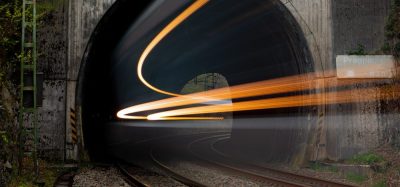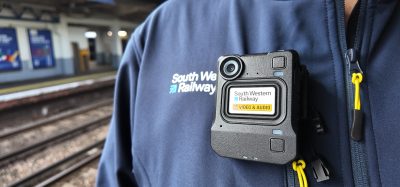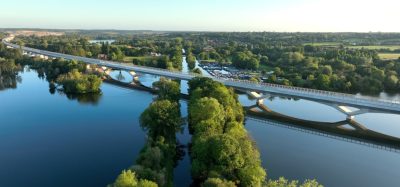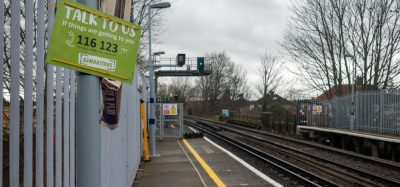NJOL’s mission to save lives at level crossings
Posted: 11 April 2019 | Todd Hirt (NJDOT & NJOL) | No comments yet
As State Coordinator for New Jersey Operation Lifesaver (NJOL) and Lead Engineer at the New Jersey Department of Transportation (NJDOT) Bureau of Railroad Engineering Services, safety is part of Todd Hirt’s everyday existence. Here he explains the importance of promoting railway dangers and NJOL’s great work to ensure level crossing safety is a way of living.
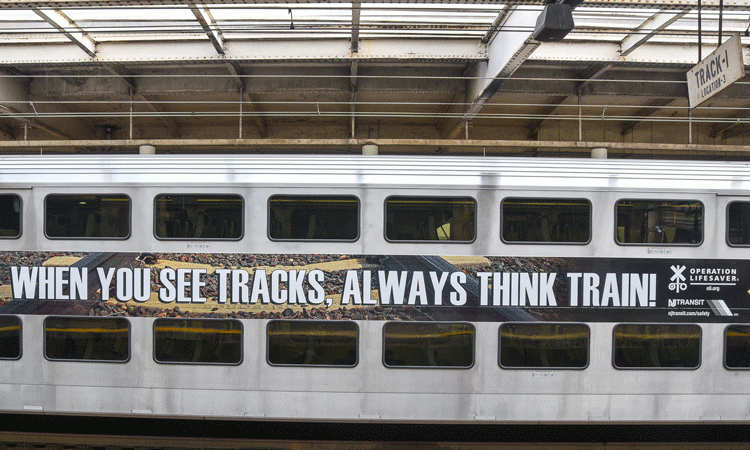

A New Jersey Transit train wrapped with the safety message 'See Tracks Think Train'
The word safety is defined as the state of being safe, the condition of being protected from harm or other non-desirable outcomes. Safety can also refer to the reduction of recognised hazards in order to achieve an acceptable level of risk. Railroad crossing safety encompasses trains, level crossings and the users of the crossing. You have likely heard slogans like: ‘Safety Saves Lives’, ‘Safety First’, ‘Think Safety’ and ‘Safety is Everyone’s Business’.
Operation Lifesaver’s mission
Operation Lifesaver is a non-profit rail safety education organisation with a mission to save lives at level crossings and along railroad rights-of-way. We provide information and materials for drivers and pedestrians who use level crossings. Each informational handout includes the phrase, ‘provided in the interest of safety’. A handout entitled ‘Make the Safe Choice’ is a guide to making safe decisions around rail systems and includes safety tips.
In writing this article, I tried to put myself in the mindset of someone who didn’t know what level crossing safety encompasses. I started by reading the handouts, with an untrained mind. The advice to look both ways seems obvious, as does the safety tip, ‘if you see a train coming, wait!’ This is common sense advice, because a train is a large steel vehicle and a person is made up of 60 per cent water. It also seems obvious that tracks are for trains, not people. I understand that, but do others? I am not so sure. I know that if I am not near the tracks, I should be safe from trains.
Engineering and level crossing safety
My work at NJDOT involves improving railroad warning devices and level crossing surfaces for 50 or more crossings per year. These safety-related improvements include installing more signage, brighter warning lights, or a gate that blocks your path. These enhancements are intended to increase the level of safety for crossing users; they are there to warn you to be safe. Are crossing users heeding the message?
NJDOT’s engineering efforts include installing innovative warning devices in addition to the standard railroad flashing lights, bells, train horn and roadway and pedestrian gates. One device is a ‘second train coming’ sign that lights up and may include an audible safety message. This sign is used in multiple track crossings to alert drivers and pedestrians.
Another new device being used is known as a gate skirt – another gate that hangs below the existing pedestrian gate to deter individuals from ducking or crawling under the existing gate. This device deters these actions to keep people safe.
Unfortunately, even with these improvements, not all level crossing users are heeding these warnings, judging by recent headlines. Man struck, killed by train. Train strikes car on tracks. Vehicle goes around gate, gets struck by train. Woman jogging down tracks, killed by train.
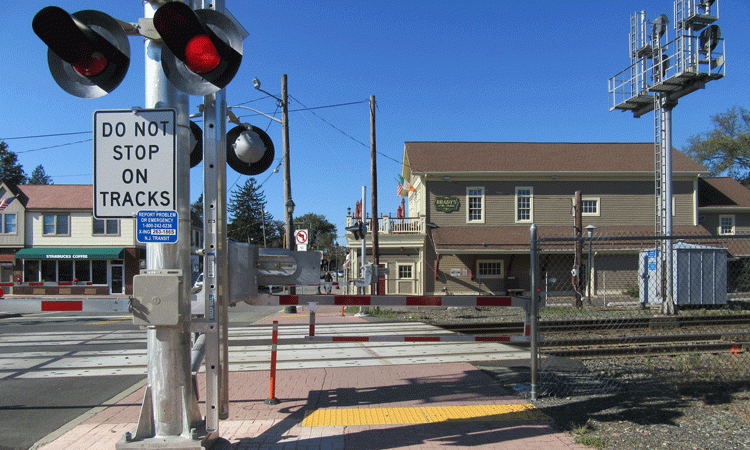

A gate skirt is another gate that hangs below the existing pedestrian gate, to deter individuals from ducking or crawling under the existing gate
Statistics tell the story
Consider this Federal Railroad Administration crossing data:
- In New Jersey (NJ), there are 1,564 public level crossings
- NJ ranks 32nd in the county for public level crossings
- Average Annual Daily Traffic (AADT) in NJ is 9,131,289, 10th in the nation by traffic volume
- New Jersians’ exposure to trains is 167,770,010 – 5th, one of the highest in the East
- Between 2013 to 2017, NJ had 125 incidents at public highway-railroad level crossings
- Between 2013 to 2017, NJ had seven fatalities and 77 injuries at public highway-railroad level crossings
- Across the U.S. during that time period there were 733 level crossing-related fatalities and 3,702 injuries.
NJ’s crash rate per AADT puts us 40th in the country; 39 states are higher and 10 are lower. In my view, the numbers are still too large. It would be nice to get to the 50th spot and even better if all states had zero crashes.
I reviewed the Federal Railroad Administration’s data for incidents involving a train in NJ for this same period and found the following interesting data:
- Ten incidents involved vehicles stopped on tracks
- One incident involved a train that struck a bus which had stopped on the tracks
- Seven incidents involved a vehicle going around lowered level crossing gates
- In 11 incidents, a vehicle tried to beat the train
- At four different locations on four occasions, a car ran into the side of a train
- Twice a tractor-trailer was struck by a train at a passive level crossing (without lights and/or gates)
- Once a tractor-trailer was struck by a train at an active level crossing (with lights and/or gates).
Only two incidents involved a passive level crossing and a vehicle, where a driver had to decide whether to go, yield or stop and look both ways. All the other incidents listed above had at a minimum a railroad crossbuck and railroad flashing lights, safety devices in place. These incidents are preventable, were they not? What will it take to go a year, two years, three years without a death or injury related to a railroad level crossing or trespassing on railroad right of way?
NJOL: 40 years of rail safety education
Reaching every person in the state with an Operation Lifesaver safety message is a challenge we are working to meet. In 2018, NJOL celebrated its 40th anniversary. We decided to mark this milestone with a 40-railroad station safety blitz, an undertaking that took us to locations we had never visited. Our 40-station blitz allowed us to talk with 8,850 citizens and gave us a chance to educate many people. One of the recurring comments we heard during our safety blitz was that Operation Lifesaver’s message of train safety was a good thing. We talked with scores of people who had heard about or knew someone who was struck by a train and killed.
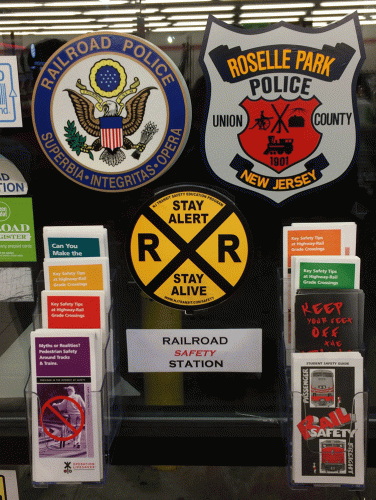

Safety kiosks have been installed at several mini marts near railroad tracks
NJOL is educating the public through a variety of outreach campaigns. Our safety messages have played at movie theatres in Bergen, Passaic and Monmouth Counties, the state’s highest trespass areas. NJOL placed a billboard outside a Starbucks in Atlantic City. We have installed safety kiosks at several mini marts near railroad tracks. NJOL partnered with New Jersey Transit to have two train cars wrapped with the safety message ‘See Tracks Think Train’. We have set up safety tables on the boardwalks along the Jersey Shore, giving away beach balls with the Operation Lifesaver pedestrian message, ‘Stay Off Stay Away, Stay Alive’. NJOL has a 14-year partnership with the Trenton Thunder, the Double A affiliates of the New York Yankees, to give our messages about safety at grade crossings, trespassing hazards and light-rail vehicle safety higher visibility. NJOL has a 10-year relationship with the 4-H and their trainmaster club, participating in their fair and train shows.
The backbone of NJOL are the trained volunteers who make presentations to school children, bus drivers, truck drivers, emergency responders, new drivers and of course the general public. Over the last five years we have reached approximately 240,000 individuals with a direct safety presentation. Our Facebook page and Twitter account share lifesaving tips with the public on the social media platforms people visit every day. We also are exploring a partnership with iHeartRadio to use geo-fencing digital ads in an area of NJ that has a high number of trespassing and railway level crossing incidents.
The bottom line
Railroad safety means empowering people through education to heed the warning to stay safe. Railroad safety means obeying the signs and warning devices at highway-railway level crossings, and not trespassing on railroad rights-of-way. Safety awareness means not ending up as a tragic statistic. Railroad level crossing safety is a way of living. It means being a safety trendsetter!
Biography


Stay Connected with Global Railway Review — Subscribe for Free!
Get exclusive access to the latest rail industry insights from Global Railway Review — all tailored to your interests.
✅ Expert-Led Webinars – Gain insights from global industry leaders
✅ Weekly News & Reports – Rail project updates, thought leadership, and exclusive interviews
✅ Partner Innovations – Discover cutting-edge rail technologies
✅ Print/Digital Magazine – Enjoy two in-depth issues per year, packed with expert content
Choose the updates that matter most to you. Sign up now to stay informed, inspired, and connected — all for free!
Thank you for being part of our community. Let’s keep shaping the future of rail together!
Related topics
Related organisations
New Jersey Department of Transportation (NJDOT), New Jersey Operation Lifesaver (NJOL)




